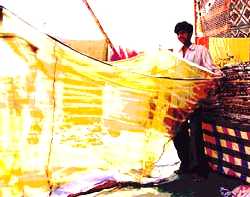Are bednets reliable?
 A study published in The Lancet by field doctors Bob Snow, Kevin Marsh and others of the Wellcome Trust in Nairobi and at the University of Oxford, has sparked off a controversy. The researchers say that insecticide-treated bednets may do more harm than good in the areas worst-hit by cerebral malaria, according to a New Scientist report.
A study published in The Lancet by field doctors Bob Snow, Kevin Marsh and others of the Wellcome Trust in Nairobi and at the University of Oxford, has sparked off a controversy. The researchers say that insecticide-treated bednets may do more harm than good in the areas worst-hit by cerebral malaria, according to a New Scientist report.
Snow and Marsh argue that by using bednets to protect children from exposure to malaria in infancy, their immunity to the disease may be reduced. Older children may thus experience worse symptoms and ultimately the number of deaths from malaria could increase. Taken as a suggestion to stop using bednets, it has been dismissed as impractical by many. But Snow says that the bottom line is that researchers simply do not know how reducing exposure to malaria in infancy will affect their survival in the long term.
The researchers took areas in Kenya and The Gambia with different intensities of malaria transmission and compared hospital admission rates. Surprisingly, the highest admission rates were in areas with moderate intensity, rather than areas where transmission intensity was highest. In other words, bednets for infants could simply be delaying the attack of fatal cerebral malaria until the children are three or older and spend less time under nets.
Other scientists question the assumptions of the study. Brian Greenwood at the London School of Hygiene and Tropical Medicine says that other factors such as geographical differences in the strains of the parasite or seasonal patterns of transmission could account for the variation. In any case, he says, the risk that bednets will increase the number of overall deaths applies only to areas with a high transmission rate, which are in a minority.
Louis Molineaux, former chief of operations research in the World Health Organization's tropical disease control division, suspects that any rise in deaths from cerebral malaria caused by bednets would be offset by the reduction in the number of deaths where malaria is just one of several causes.
The only way to find out for certain would be a long-term megatrial. Most researchers rule this out as impractical. Snow and others, meanwhile, are trying to develop 'risk maps' of transmission intensity to develop guidelines for 'rational use' of bednets in Africa.
